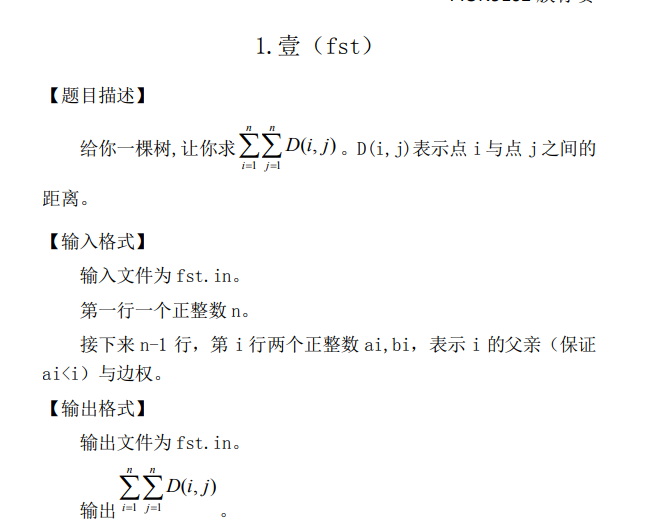浪了一发普及模拟赛

【样例输入】
4
1 1
2 1
1 1
【样例输出】
20
【数据规模和范围】
对于 30%的数据,n≤1000。
对于另外 30%的数据,bi=1。
对于 100%的数据,n≤1 000 000,bi≤1000。
sol:单边记贡献,(x,y)边的贡献就是 Size[y]*(n-Size[y])*Dis[x][y],因为父亲都小于当前点,直接倒着跑一遍记Size就可以了,如果无序的话可以用拓扑

#include <bits/stdc++.h> using namespace std; typedef long long ll; inline ll read() { ll S=0; bool f=0; char ch=' '; while(!isdigit(ch)) { f|=(ch=='-'); ch=getchar(); } while(isdigit(ch)) { S=(S<<3)+(S<<1)+(ch-'0'); ch=getchar(); } return (f)?(-S):(S); } #define R(x) x=read() inline void write(ll x) { if(x<0) { putchar('-'); x=-x; } if(x<10) { putchar(x+'0'); return; } write(x/10); putchar(x%10+'0'); return; } #define W(x) write(x),putchar(' ') #define Wl(x) write(x),putchar('\n') const int N=1000005; int n,Father[N],Size[N]; int Val[N]; int main() { freopen("fst.in","r",stdin); freopen("fst.out","w",stdout); int i; ll ans=0; R(n); for(i=1;i<=n;i++) { Size[i]=1; } for(i=2;i<=n;i++) { Father[i]=read(); Val[i]=read(); } for(i=n;i>1;i--) { Size[Father[i]]+=Size[i]; } for(i=2;i<=n;i++) { ans+=1ll*Val[i]*Size[i]*(n-Size[i]); } Wl(ans<<1); return 0; } /* input 5 1 2 2 4 2 1 4 4 output 92 input 5 1 5 1 5 2 3 2 5 output 164 */
2.贰(fstagain)
【题目描述】
给你一个长度为 n 的序列,有 m 次询问,让你求区间 gcd。
【输入格式】
输入文件为 fstagain.in。 第一行两个正整数 n 和 m。 第二行 n 个正整数 ai,保证 ai≤1 000 000 000。 接下来 m 行,每行两个正整数 l 和 r,询问序列中 l 到 r 的 gcd。
【输出格式】
输出文件为 fst.in。 输出 m 行,表示查询的结果。
【样例输入】
3 2
3 6 8
1 2
2 3
【样例输出】
3
2
【数据规模和范围】
对于 30%的数据,n,m≤1000。
对于 60%的数据,n≤1000。
对于 100%的数据,n,m≤100000。
sol:因为重复没关系,ST表可以搞,线段树应该也可以做(反正是模板),我写了分块(反正都能过)

#include <bits/stdc++.h> using namespace std; typedef int ll; inline ll read() { ll S=0; bool f=0; char ch=' '; while(!isdigit(ch)) { f|=(ch=='-'); ch=getchar(); } while(isdigit(ch)) { S=(S<<3)+(S<<1)+(ch-'0'); ch=getchar(); } return (f)?(-S):(S); } #define R(x) x=read() inline void write(ll x) { if(x<0) { putchar('-'); x=-x; } if(x<10) { putchar(x+'0'); return; } write(x/10); putchar(x%10+'0'); return; } #define W(x) write(x),putchar(' ') #define Wl(x) write(x),putchar('\n') const int N=100005,B=355; int n,m,a[N]; int Block,cnt,L[B],R[B],Gcd[B],Pos[N]; inline int gcd(int x,int y) { return (!y)?(x):(gcd(y,x%y)); } inline void Pre() { int i,j; Block=sqrt(n); cnt=n/Block+(bool)(n%Block); for(i=1;i<=cnt;i++) { L[i]=R[i-1]+1; R[i]=L[i]+Block-1; } R[cnt]=n; for(i=1;i<=cnt;i++) { Gcd[i]=a[L[i]]; Pos[L[i]]=i; for(j=L[i]+1;j<=R[i];j++) { Pos[j]=i; Gcd[i]=gcd(Gcd[i],a[j]); } } return; } inline int Solve(int l,int r) { int i; int ql=Pos[l],qr=Pos[r]; if(ql+1>=qr) { int ans=a[l]; for(i=l+1;i<=r;i++) { ans=gcd(ans,a[i]); } return ans; } else { int ans=a[l]; for(i=l+1;i<L[ql+1];i++) { ans=gcd(ans,a[i]); } for(i=ql+1;i<qr;i++) { ans=gcd(ans,Gcd[i]); } for(i=L[qr];i<=r;i++) { ans=gcd(ans,a[i]); } return ans; } } int main() { freopen("fstagain.in","r",stdin); freopen("fstagain.out","w",stdout); int i; R(n); R(m); for(i=1;i<=n;i++) { R(a[i]); } Pre(); for(i=1;i<=m;i++) { int l=read(),r=read(); Wl(Solve(l,r)); } return 0; } /* input 3 2 3 6 8 1 2 2 3 output 3 2 */
3.叁(fstalways)
【题目描述】
有 4 种硬币,面值分别为 c1,c2,c3,c4。某人去商店买东西,去 了 tot 次。每次带 di 枚 ci 硬币,买 s 的价值的东西。求每次有多少 种付款方法。
【输入格式】
输入文件为 fstalways.in。 第一行 5 个正整数 c1,c2,c3,c4,tot。 接下来 tot 行,每行 5 个正整数表示的 d1,d2,d3,d4,s。
【输出格式】
输出文件为 fstalways.out。 输出 tot 行,表示每次的方案数。
【样例输入】
1 2 5 10 2
3 2 3 1 10
1000 2 2 2 900
【样例输出】
4
27
【数据规模和范围】
对于 30%的数据,di≤10。
对于 50%的数据,s,tot≤1000。
对于 100%的数据,s≤1000000,tot≤100000。
sol:先跑一遍没有 di 限制的背包,然后容斥,奇加偶减(这是套路)
容斥过程:对于S,选择第 i 种硬币超限的方案数就是 dp[S-(di+1)*c[i]],因为是完全背包,剩下的S-(di+1)*c[i]可以随便选,然而就算一个 i 也不选也是会超限的

#include <bits/stdc++.h> using namespace std; typedef long long ll; inline ll read() { ll s=0; bool f=0; char ch=' '; while(!isdigit(ch)) { f|=(ch=='-'); ch=getchar(); } while(isdigit(ch)) { s=(s<<3)+(s<<1)+(ch^48); ch=getchar(); } return (f)?(-s):(s); } #define R(x) x=read() inline void write(ll x) { if(x<0) { putchar('-'); x=-x; } if(x<10) { putchar(x+'0'); return; } write(x/10); putchar((x%10)+'0'); return; } #define W(x) write(x),putchar(' ') #define Wl(x) write(x),putchar('\n') int C[5],D[5]; ll dp[1000005]; int main() { freopen("fstalways.in","r",stdin); freopen("fstalways.out","w",stdout); int i,j,T,Sum; ll ans=0; for(i=1;i<=4;i++) { R(C[i]); } R(T); dp[0]=1; for(i=1;i<=4;i++) { for(j=C[i];j<=1000000;j++) { dp[j]+=dp[j-C[i]]; } } while(T--) { ans=0; for(i=1;i<=4;i++) { R(D[i]); } R(Sum); for(i=0;i<=15;i++) { int SS=Sum,Bo=1; for(j=1;j<=4;j++) if(i&(1<<(j-1))) { SS-=C[j]*(D[j]+1); Bo^=1; } if(SS<0) continue; if(Bo) ans+=dp[SS]; else ans-=dp[SS]; } Wl(ans); } return 0; } /* input 1 2 5 10 2 3 2 3 1 10 1000 2 2 2 900 output 4 27 */
4.肆(fstforever)
【题目描述】
给定一棵 n 个节点的有根树,编号依次为 1 到 n,其中 1 号点为 根节点。每个点有一个权值 vi。 现在,你需要选择尽可能多的节点,满足以下的性质:对于任意 两个点 i,j,如果 i 在树上是 j 的祖先,那么 vi>vj。请计算可选的最 多的点数。
【输入格式】
输入文件为 fstforever.in。 第一行一个正整数 n。 第二行 n-1 个正整数 ai,表示 i+1 的父亲(ai≤i+1)。 第三行 n 个整数,第 i 个整数表示 vi。 【输出格式】 输出文件为 fstforever.out。 输出一个整数,为最多的点数。
【样例输入】
6
1 1 1 1 1
3 1 2 3 4 5
【样例输出】
5
【数据规模和范围】
对于 30%的数据,n≤20。
对于 50%的数据,保证 n≤3000。
对于另外 20%的数据,保证 ai=i。
对于 100%的数据,vi≤1 000 000 000,n≤200000。
sol:对于一条链,就是跑最长上升子序列,在一棵树上是 ,我们发现对于一个非叶子节点,他所有儿子都是等价的,用multiset启发式合并就可以了
其实着重解释一下一种求LIS的方法 为什么是对的
方法是这样的:维护一个multiset,即每次新加一个元素时,在维护的multiset中找到比它大的第一个元素,替换,(如果没有就直接加入这个元素)最后multiset的长度就是LIS的长度。
为什么是替换掉比他大的第一个,而不是把所有比他大的都去掉呢?
(1)如果被替换掉的是multiset里最大的元素,就表示当前点的值加入当前维护的LIS中,并在维护的LIS中删除被替换的值
(2)如果替换之后,multiset里有比当前节点的值更大的元素,就表示不将当前节点的值加入LIS,LIS的长度不变
(3)如果没有更大的元素,就直接加入当前的值,LIS长度+1。
每次新加入元素的时候其实只跟当前LIS里最大的元素有关
要么是加入新元素,最大元素变小,LIS长度不变
要么是加入新元素、最大元素变大、LIS长度+1
要么是不加入新元素、LIS不变

#include <bits/stdc++.h> using namespace std; typedef int ll; inline ll read() { ll s=0; bool f=0; char ch=' '; while(!isdigit(ch)) { f|=(ch=='-'); ch=getchar(); } while(isdigit(ch)) { s=(s<<3)+(s<<1)+(ch^48); ch=getchar(); } return (f)?(-s):(s); } #define R(x) x=read() inline void write(ll x) { if(x<0) { putchar('-'); x=-x; } if(x<10) { putchar(x+'0'); return; } write(x/10); putchar((x%10)+'0'); return; } #define W(x) write(x),putchar(' ') #define Wl(x) write(x),putchar('\n') const int N=200005,M=400005; int n,Val[N]; struct Tree { int tot,Next[M],to[M],head[N]; inline void add(int x,int y) { Next[++tot]=head[x]; to[tot]=y; head[x]=tot; return; } multiset<int>S[N]; inline void Merg(int x,int y) { multiset<int>::iterator it; if(S[x].size()<S[y].size()) swap(S[x],S[y]); for(it=S[y].begin();it!=S[y].end();it++) { S[x].insert(*it); } return; } inline void dfs(int x) { int i; for(i=head[x];i;i=Next[i]) { dfs(to[i]); Merg(x,to[i]); } if(S[x].size()) { multiset<int>::iterator it; it=S[x].lower_bound(Val[x]); if(it!=S[x].end()) { S[x].erase(it); } } S[x].insert(Val[x]); return; } inline void Init() { tot=0; memset(head,0,sizeof head); return; } }T; int main() { freopen("fstforever.in","r",stdin); freopen("fstforever.out","w",stdout); int i; R(n); T.Init(); for(i=2;i<=n;i++) { T.add(read(),i); } for(i=1;i<=n;i++) { R(Val[i]); } T.dfs(1); Wl(T.S[1].size()); return 0; } /* input 6 1 1 1 1 1 3 1 2 3 4 5 output 5 */
